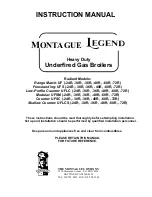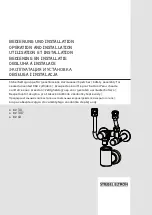
64
LP-520 REV. 7.26.16
2. The appliance must be isolated from the gas supply piping system by closing its individual manual shutoff valve during any pressure
testing of the gas supply piping system at test pressures equal to or less than ½ psi (3.5 kPa).
NOTICE
Do not fire (operate) the appliance until all connections have been completed and the heat exchanger is filled with water. Doing so will
damage the appliance and void the warranty.
ADJUSTING GAS PRESSURE AT THE APPLIANCE
1. Open the gas line and water valves.
2. Use a Phillips Head screwdriver to remove the appliance top cover. Remove the front cover.
3. Loosen the gas inlet pressure tap screw three turns with a screwdriver. Connect the manometer to the inlet gas pressure port. See
Figure 49.
4. Turn on power to the appliance and open a hot water faucet.
5. The minimum and maximum inlet gas line pressures must meet the requirements shown in Table 26.
LP GAS
NATURAL GAS
Minimum Pressure
3.5” WC
Minimum Pressure
3.5” WC
Maximum Pressure
14” WC
Maximum Pressure
14” WC
Table 27
– Gas Pressure Requirements
6. Remove the manometer. Close the screw on the gas inlet pressure tap.
K. SETTING AND VERIFYING THE COMBUSTION SETTING
1. After the appliance has fired, flip DIP switch seven (7) to the ON position (low fire). Proceed to check appliance combustion values.
NOTE:
Use a combustion analyzer to ensure CO and CO
2
values are within the range shown in Table 27.
It is required to use a combustion analyzer to verify final adjustment according to the combustion chart (Table 27). Failure to do so
could result in serious personal injury or death.
If the readings obtained are lower or higher than the combustion readings in Table 27, use a 4mm Allen key to adjust the offset screw in
a clockwise (positive) or counterclockwise (negative) direction (approximately 1/4 turn). See Figure 50. Check your combustion values.
Repeat this procedure until the values obtained on the combustion analyzer agree with those stated in Table 27.
NOTE:
If the appliance makes a whistling sound (harmonics) at low fire, adjust the offset screw in a clockwise (positive) direction
(approximately 1/8 turn). Check your combustion values and ensure they agree with those stated in Table 27 before proceeding.
It is very important that this conversion be set within the recommended CO measurements listed in Table 27. Visually looking at the
burner does not determine combustion quality. Failure to measure combustion with a Combustion Analyzer and set the throttle within
the recommended CO measurements could result in property damage, severe personal injury, or death.
COMBUSTION SETTINGS FOR 140W / 199W
Figure 50
– Gas Valve Offset Screw
NATURAL GAS
LP GAS
FAN SPEED
LOW
HIGH
LOW
HIGH
CO PPM
<60
<200
<60
<200
CO
2
(%)
8 - 10
8 ½ - 10 ½
9
– 10 ½
9 ½ - 10 ½
Table 28
– Combustion Settings
2. When low fire settings have been obtained, flip DIP switch seven (7) to its original (OFF) position. This will return the appliance to
normal mode.
*3. Flip DIP switch six (6) to ON (high fire). Again check combustion readings with a combustion analyzer.
Содержание EFTC-140W
Страница 2: ...2 LP 520 REV 7 26 16 ...
Страница 20: ...20 LP 520 REV 7 26 16 Figure 8 Water Pressure vs Flow Through the Restrictors 140W Models ...
Страница 35: ...35 LP 520 REV 7 26 16 Figure 24 Piping Legend ...
Страница 44: ...44 LP 520 REV 7 26 16 Figure 32 Electrical Wiring Diagram ...
Страница 45: ...45 LP 520 REV 7 26 16 Figure 33 Ladder Diagram ...
Страница 87: ...87 LP 520 REV 7 26 16 TECH SIGN OFF Table 43 Continue annual maintenance beyond the 4 th year as required ...
Страница 88: ...88 LP 520 REV 7 26 16 ...
Страница 89: ...89 LP 520 REV 7 26 16 ...
















































